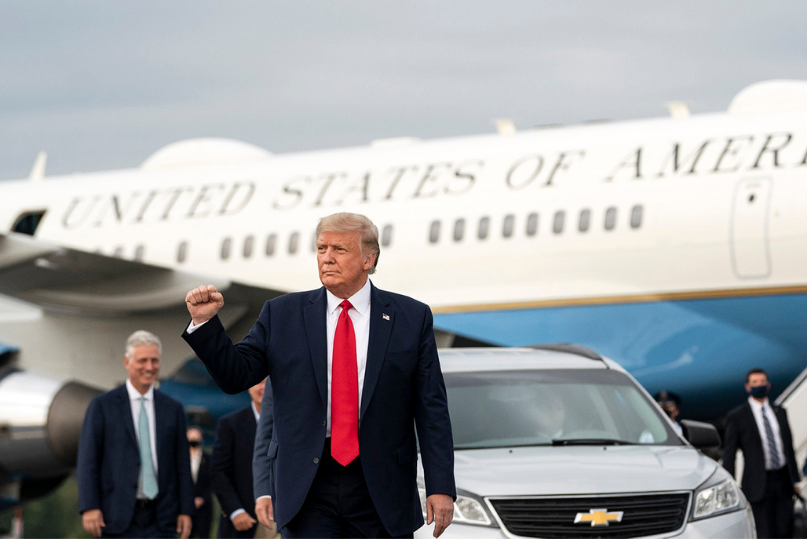
When President Trump announced his presidential campaign five years ago, he made a commitment to fight for American jobs, and without a doubt, that promise was kept.
This Labor Day, let’s take a look at President Trump’s accomplishments for the American worker.
Tax Cuts:
- In 2017, a typical American household earning $75,000 in pre-tax wages was paying $3,983 in federal income taxes. Each month, $347 was withheld from their paychecks, and they received a $178 refund when they filed their 2017 taxes. In 2018, that typical family earning $75,000 saw their total taxes fall to just $1,739, a tax reduction of $2,244 per family. The tax cut was mostly realized through the nearly $200 per month added to their paychecks.
- President Trump’s 2017 tax cuts reduced the U.S. tax burden to one of the lowest among major world economies
- Eighty-two percent of middle-class households received a tax cut.
- In 2018, the average individual income tax cut was $1,260 increasing after-tax incomes 1.7 percent
Opportunity Zones:
- Opportunity Zones empower our community leaders, mayors, and governors to come together to decide for themselves which of their neighborhoods should be designated to participate.
- The Opportunity Zone initiative has created compelling tax incentives to drive investment to 8,700 distressed ZIP codes nationwide.
- Many Opportunity Zones the president has created in low-income and predominantly black areas have revitalized areas neglected under Democratic administrations.
Trade Deals
- President Trump got rid of the disastrous NAFTA that outsourced millions of American jobs & Joe Biden backed and replaced it with USMCA, a better deal for American workers, manufacturers, and farmers that will incite strong economic growth and more jobs.
- USMCA is projected to add $68.2 billion to the U.S. economy and create 176,000 new jobs.
- The White House trade office projected USMCA will spur $34 billion in investments in U.S. auto plants, $23 billion in American auto parts sales, and create 76,000 new industry jobs over the course of five years. The employment gains would include roughly 22,800 automotive assembly jobs, 8,000 additional advanced battery supplier jobs, and 45,600 additional automotive supplier jobs.
- U.S. exports to Canada and Mexico would increase by $19.1 billion and $14.2 billion
- Dairy exports to Canada will grow $227M
- President Trump achieved a Phase One Trade Agreement with China.
- China is going to increase purchases of U.S. agriculture, energy services, and manufactured goods by $200 billion over two years, compared to a 2017 baseline.
- China agreed to further open its financial services markets to U.S. banks, credit card companies, and other financial institutions.
- China agreed to remove so-called non-tariff barriers that have blocked sales of U.S. agriculture and seafood products, including for meat, poultry, seafood, rice, dairy, pet food, and biotechnology.
- The U.S. cuts the tariff rate in half—from 15% to 7.5% on roughly $120 billion in Chinese products, including shoes and apparel.
- A 25% tariff on $250 billion of Chinese goods remains in place.
- President Trump fulfilled his promise to renegotiate the United States-Korea Free Trade Agreement (KORUS), providing a boost to American auto exports.
- 100 percent increase in the number of cars U.S.-based auto manufacturers can export to South Korea
- Korea agreed to a U.S. demand to extend a 25 percent U.S. tariff on light‐truck imports until 2041
- Korea amended its Premium Pricing Policy for Global Innovative Drugs to make it consistent with Korea’s commitments under KORUS to ensure non‐discriminatory and fair treatment for U.S. pharmaceutical exports.
DEREGULATION:
- President Trump’s deregulation efforts have already reduced regulatory costs by $50 billion and are on track to reduce regulatory costs by at least that much in fiscal year 2020 alone.
- The President’s Governors’ Initiative on Regulatory Innovation is working to reduce outdated regulations, advance occupational licensing reform, and align Federal and State regulations.
- President Trump is rolling back regulations that harm American workers, including providing relief to farmers by repealing the burdensome Obama-era Waters of the United States Rule.
- In 2019, the president signed two executive orders to increase transparency in Federal agencies and protect Americans and their small businesses from administrative abuse.
- President Trump’s Administration cut red tape in the healthcare industry, providing Americans with more affordable healthcare and saving Americans nearly 10 percent on prescription drugs.
- Deregulation of both prescription drugs and internet access helped the poorest fifth of households eight times more than the wealthiest fifth of Americans.
- The Administration replaced costly Obama-era fuel standards with the Safer Affordable Fuel Efficient (SAFE) Vehicles rule, making cars more affordable for low-income Americans.
- This rule is expected to lower the price of new vehicles by $2,200, according to the Council of Economic Advisers.
- President Trump established a council to reduce regulatory barriers to affordable housing.
- The president’s deregulatory actions will increase household income annually by at least $3,100 in the coming years.
- President Trump has signed 16 pieces of deregulatory legislation that are expected to result in a $40 billion increase in annual real incomes.
- Once fully in effect, 20 major deregulatory actions undertaken by the Administration are expected to save American consumers and businesses over $220 billion per year.
- The implementation of the SAFE Vehicles Rule is estimated to increase the real incomes of Americans by $53 billion per year over the 2021-2029 period.
- Deregulation is helping small businesses invest and expand by saving them from dedicating time and money on compliance costs.
- The President’s deregulatory actions are also increasing the competition, productivity, and wages of American workers.




